Routes of Santiago de Compostela in France: For more than 1000 years. pilgrims have been walking along the Route of Santiago de Compostela, also known as the Way of St. James, or in Spanish: Camino de Santiago. Their final destination is the tomb of St. James the Apostle in the Cathedral of Santiago de Compostela. Santiago de Compostela in Spain is one of the most important Christian pilgrimage destinations, along with Jerusalem and Rome. The four main starting points of the Route of Santiago de Compostela in France are Parijs, Arles, Le Puy and Vézelay. Each of these routes was fed by numerous subsidiary routes, coming from all over Europe. The branches of the Route of Santiago de Compostela crosses the French-Spanish border and joins the Route of Santiago de Compostela in Spain. From the town of Puente la Reina in Spain, the route continues westwards to Santiago de Compostela. Numerous places of worship have been built on the Route of Santiago de Compostela. World Heritage monuments on the Route of Santiago de Compostela consists mainly of cathedrals, chapels and churches, but also hospices and pilgrims bridges. Some of the major Christian pilgrimage destinations in France: the cathedrals of Amiens, Chartres and Bourges, the widest of the Gothic cathedrals in France, and Mont Saint-Michel. Also notable is the Saint Hilaire Church in Melle. The Routes of Santiago de Compostela in France were declared a UNESCO World Heritage in 1998.
www.werelderfgoedfotos.nl © Copyright World Heritage Photos classic car road trip
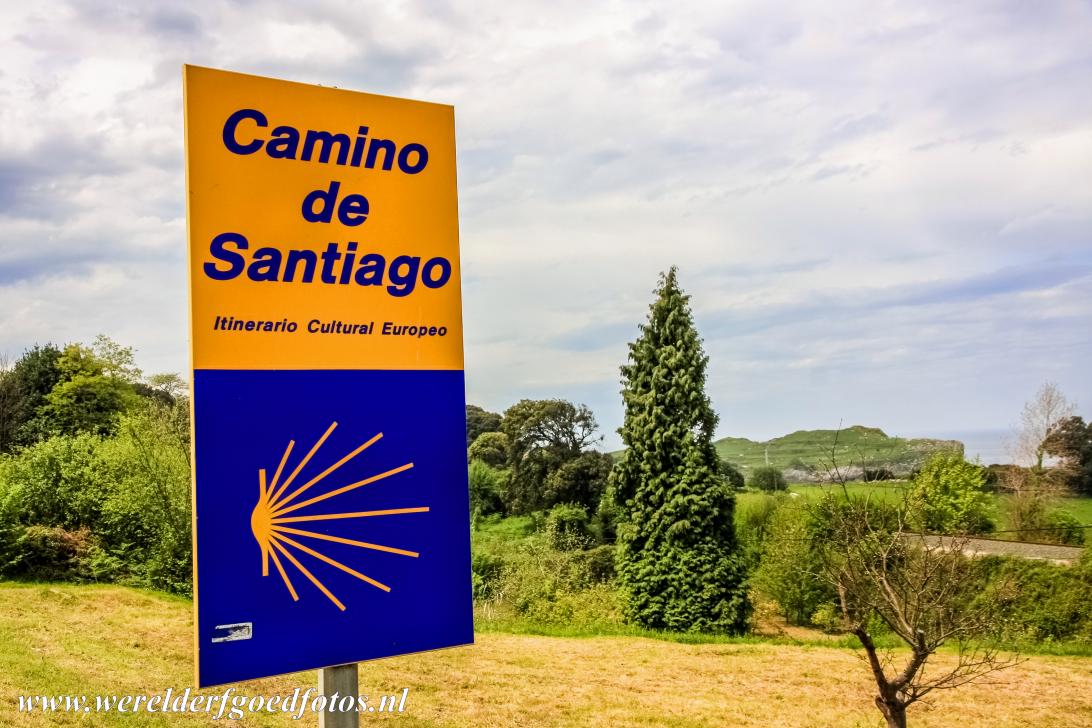
The four principal starting points of the route of Santiago de Compostela in France are: Arles, Parijs, Vézelay and Le Puy. Each of these routes is fed by a large number of a subsidiary routes, coming from all over Europe. The branches of the route of Santiago de Compostela crosses the French-Spanish border and joins the routes of Santiago de Compostela in Spain. From Puente la Reina in Spain, the pilgrimage route continues in a northern and southern route to Santiago de Compostela in Spain.

The four principal starting points of the route of Santiago de Compostela in France are: Arles, Parijs, Vézelay and Le Puy. Each of these routes is fed by a large number of a subsidiary routes, coming from all over Europe. The branches of the route of Santiago de Compostela crosses the French-Spanish border and joins the routes of Santiago de Compostela in Spain. From Puente la Reina in Spain, the pilgrimage route continues in a northern and southern route to Santiago de Compostela in Spain.
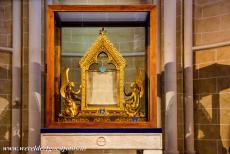
Routes of Santiago de Compostela in France: The Sancta Camisia is the most precious relic in Chartres Cathedral. The Sancta Camisia is also known as the tunic of the Virgin Mary. In 876, the relic was a gift from Charlemagne. Chartres Cathedral was built following the fire that destroyed a previous church in 1194, only the western façade, the crypt and the precious Sancta Camisia survived. The cathedral is located on one of the subsidiary routes of the Via Turonensis, one of the four principal routes in France leading to Santiago de Compostela.
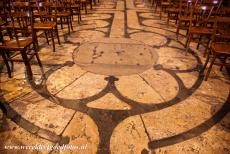
Routes of Santiago de Compostela in France: The Chartres Labyrinth, inlaid in the nave floor of Chartres Cathedral. The Chartres Labyrinth is 12.9 metres in diameter, it is the largest medieval Labyrinth in the world. Pilgrims used to follow the tortuous labyrinth on the knees. The labyrinth continues to receive visits from pilgrims to this day. The cathedral is also famous for its stained glass windows, dating from 12th and 13th centuries. The cathedral is one of the most important Christian monuments on the route of Santiago de Compostela and a popular tourist attraction.
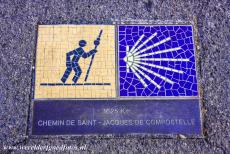
Routes of Santiago de Compostela in France: A symbol of the pilgrimage route close to Chartres Cathedral. The pilgrimage route is also known as the Way of St. James or El Camino de Santiago (in Spanish). The scallop shell, also called the Shell of Saint James, is the symbol of the Route of Santiago de Compostela. The Routes of Santiago de Compostela in France gained the status as a UNESCO World Heritage in 1998.
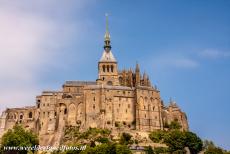
Routes of Santiago de Compostela in France: One of the branches of the route of Santiago de Compostela, the Mont-Saint-Michel Way, starts at Mont-Saint-Michel and is leading to the south of the historic town of Saintes, where it joins the route from Paris and Tours, the Via Turonensis. UNESCO World Heritage monuments on the route of Santiago de Compostela consist of a huge number of buildings such as cathedrals and churches, Mont Saint-Michel is one of them.
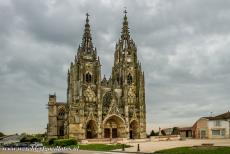
Routes of Santiago de Compostela in France: The Notre-Dame de L'Epine is a basilica in the tiny village of L'Epine near Verdun and Châlons-en-Champagne. The basilica was built in 1406 - 1527 and has the dimensions of a cathedral. Remarkable gargoyles give the basilica a very mysterious character. The Notre-Dame de L'Epine is a true masterpiece of the Flamboyant Gothic style. The basilica is part of the UNESCO World Heritage: Routes of Santiago de Compostela in France.
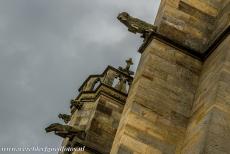
Route of Santiago de Compostela in France: The Basilica Notre-Dame de L'Epine in the village of L'Epine, the exterior walls of the basilica are adorned with gruesome gargoyles, they symbolizes evil spirits and deadly sins. In the 19th century, the most obscene gargoyles were destroyed by puritans. Notre-Dame de L'Epine has been a pilgrimage site since medieval times. Notre-Dame de L'Epine has inspired numerous writers, especially Victor Hugo and Alexandre Dumas.
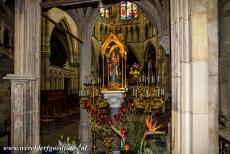
Routes of Santiago de Compostela in France: The Basilica Notre-Dame de L'Epine houses a 15th century rood screen consisting a miraculous statue of the Virgin. In the Middle Ages, the statue was found by shepherds in a burning thorn bush. Notre-Dame de L'Epine (l'épine is the French word for thorn) has been a pilgrimage destination since medieval times, even numerous French Kings visited the basilica to honour the statue of the Virgin.
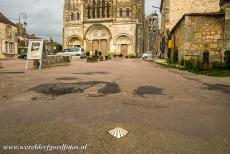
Routes of Santiago de Compostela in France: The Basilica of Vézelay, the Basilica of Saint Mary Magdalene, is the starting point of the Via Lemovicensis, one of the four main routes of the Way of St. James. The basilica in the village of Vézelay was a major destination of medieval Christian pilgrimage. The relics of Mary Magdalene were brought to Vézelay in 1281. The relics are kept in the crypt of the basilica. Vézelay Abbey is renowned for its exceptional Romanesque sculptures that adorn the tympanums and column capitals.
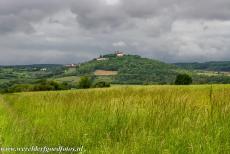
Route of Santiago de Compostela in France: The basilica on top of the hill La Colline Eternelle at Vézelay. The Basilica of Vézelay is the starting point of the Via Lemovicensis, also known as Voie de Vézelay, one of the four principal routes of the route of Santiago de Compostela, the Way of James. For more than thousand years, pilgrims have been walking the Camino de Santiago, the Way of St. James, one of the most important Christian pilgrimage routes. Their final destination is the Cathedral of Santiago de Compostela with the tomb of the Apostle Saint James.
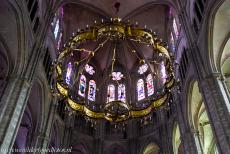
Routes of Santiago de Compostela in France: A gigantic wheel chandelier hanging down from the vaulted ceiling of Bourges Cathedral. The 13th century stained glass windows illuminates the cathedral with coloured light. The cathedral was built on the site of a place of worship, since the 3th century a pilgrimage site. The cathedral is situated on the Via Lemovicensis, one of the four traditional main routes of the routes of Santiago de Compostela in France. The starting point of the Via Lemovicensis is the Basilica of Saint Mary Magdalene in Vézelay.
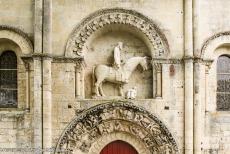
Routes of Santiago de Compostela in France: A statue of a horseman above the north entrance door of the Saint Hilaire Church in the French town of Melle, the lying figure probably represent the Ancient Law or paganism, the horse tramples the lying figure, violating the Ancient Law and triumphing over paganism. The church is renowned for its numerous Romanesque sculptures, the Romanesque hall church was built in the 11th and 12th centuries. The Saint Hilaire Church in Melle is a monument on the pilgrimage route to Santiago de Compostela in Spain.
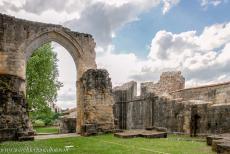
Routes of Santiago de Compostela in France: The ruins of the Grande-Sauve Abbey, also known as the Sauve-Majeure Abbey. The Benedictine abbey was founded in 1079. Due to its location on the pilgrimage route to Santiago de Compostela, the abbey quickly grew into a very wealthy and powerful monastery. The abbey was damaged during the Hundred Years' War and abandoned after the French Revolution. The abbey was partly destroyed by fire in 1910. The remaining part of the abbey is now a Romanesque monument. The abbey is located in the village of La Sauve.
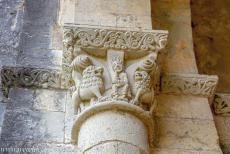
Routes of Santiago de Compostela in France: One of the capitals of the Grande-Sauve Abbey, the Romanesque sculpture depicts Daniel in the Lion's Den. Daniel was an Old Testament figure. The scene of the Bible story Daniel between the lions was mainly popular on capitals during the Romanesque period, examples of this scene can be found in many religious buildings, especially throughout France, northern Italy and northern Spain. The Grande-Sauve Abbey is renowned for its Romanesque sculpted capitals.
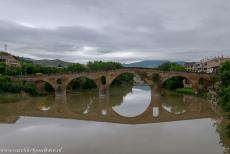
Routes of Santiago de Compostela in France: The Romanesque bridge of Puente la Reina. The branches of the routes of Santiago de Compostela in France crosses the French-Spanish border where it joins the route of Santiago de Compostela in Spain at the Romanesque stone bridge of Puente la Reina. For a long time, the bridge was the only river crossing over the Arga River. The 11th century arch bridge is accessible on foot only. The village of Puente la Reina (Bridge of the Queen) is situated between Estella and Pamplona on the route of Santiago de Compostela.
